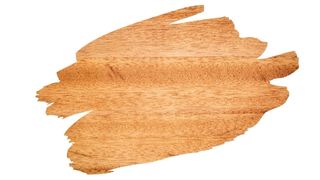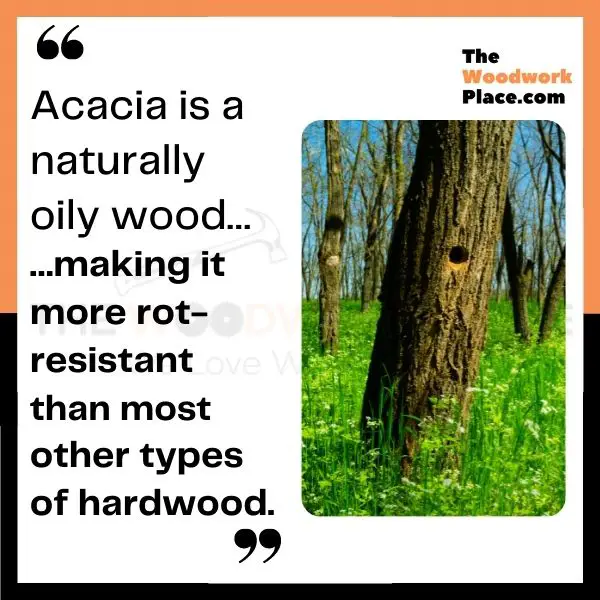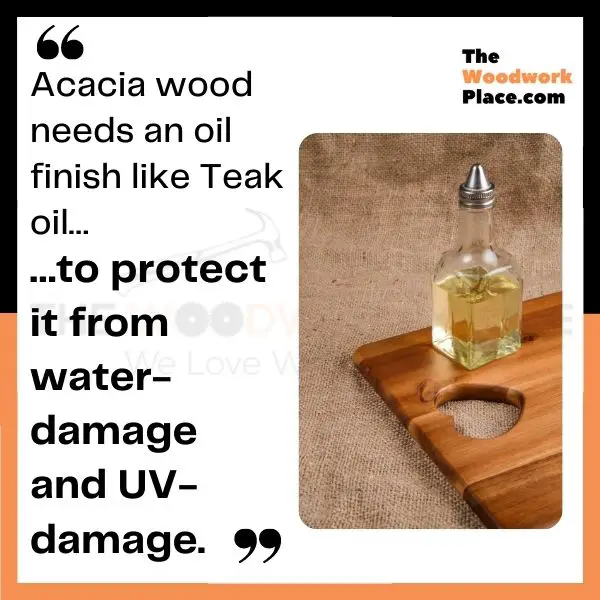You already know that Acacia wood is a great choice for outdoor furniture. This budget-friendly hardwood could even give Teak wood patio sets a run for their money.
Yet, Acacia wood isn’t anywhere near as durable as Teak wood. And Acacia garden furniture will dry out if it isn’t oiled regularly.
But, will applying Teak oil on Acacia be enough to safeguard this subtropical timber from the elements?
Well, in this post, you will find out what makes Acacia wood a naturally durable and rot-resistant lumber. You will also learn what the best oil is for Acacia wood, (whether it be for interior items or outdoor furniture).
And we reveal what really goes into Teak oil…and why your Acacia garden set may need this particular finish.

This post may contain affiliate links to products that we receive a commission for (at no additional cost to you). Learn more here.
What Kind Of Oil’s Best For Acacia Wood?
The best kind of oil for Acacia wood depends on what that Acacia wood is being used for.
If you want to finish an Acacia wood cutting board, then you need to use a food-safe non-drying oil such as mineral oil. This oil will soak into that chopping block, and protect Acacia from the inside out.
Related Post: Acacia Vs Maple Cutting Boards (4 Key Pros And Cons)
However, if you’re oiling Acacia outdoor furniture, then you should use pure Tung oil (and avoid using Linseed oil products). This is because Tung oil doesn’t run the risk of having mold grow on it, (unlike a Linseed oil finish).
But, if you want to oil Acacia indoor furniture, then you can use a drying oil finish such as Linseed oil. You can also apply fast-drying penetrating oils such as Boiled Linseed oil (BLO) and Danish oil.
Why Does Mold Sometimes Grow On Linseed Oil Finishes? Raw linseed oil is a very (very!) slow drying oil that’s extracted from flaxseed. This food-sourced oil contains proteins that fungi thrive on. If Linseed oil gets wet, (before the oil has dried and hardened), then mold will have time to grow on this finish.

And What About Teak Oil? What Is It Exactly?
Teak oil is a penetrating oil finish, just like Danish oil. But, what many people don’t know is that, (similarly to Danish oil), Teak oil is a blended oil recipe.
Danish oil contains Linseed oil and/or Tung oil, mineral spirits, and varnish. While Teak oil also contains Linseed oil and/or Tung oil, mineral spirits, and varnish…with UV inhibitors thrown in.
Now, there is a well known naturally oily type of lumber called Teak wood. The natural oils produced by the Teak tree act like its own wood preserving oil finish.
Teak wood is so oily, that penetrating oil finishes struggle to soak into this durable lumber. In fact, Teak wood can last for decades without requiring any kind of oil finishing treatment. Which is why Teak wood is widely used for garden sets and decking.
But, when it comes to Teak oil, this oil finish does not contain any natural oil from the Teak tree. Instead, Teak oil is just another Linseed/Tung derivative product.
And, if you browse through and look at all of those different Teak oil product labels, you’ll notice that no two Teak oil brands are the same.
Related Post: Deciding Between Teak Oil Vs Varnish (Best Practice Revealed)
So, Why Is It Called Teak Oil?
Teak oil was originally created to be applied onto Teak wood… hence the name Teak oil.
Still, while Teak wood rarely needs to be oiled, it will need some kind of protection from UV rays. If Teak wood is left outside, then UV sun-rays will weather this wood.
And, over time, that UV damage will change Teak woods color from amberlike-honey to ashen-gray.
But with a coat of UV inhibiting oil finish, you can prevent this weathering color change from happening. And this is where Teak oil comes in to help out.

Does Acacia Wood Need To Be Oiled?
Acacia wood is a special kind of hardwood. That is because this lumber also contains its own natural rot-resistant wood preserving oils.
This natures-own oil makes Acacia more durable than other hardwoods. And Acacia is much better equipped (than its hardwood counterparts) to resist moisture, rot, and decay.
However, Acacia wood is not as oily as Teak wood. So, unlike Teak wood, Acacia wood will need regular applications of an oil finish to safeguard it from decay.
Can Acacia Wood Be Left Outside? It absolutely can. In fact, this wood can be a more affordable alternative to Teak wood garden furniture and decking.
Can You Use Teak Oil On Acacia Wood?
You can use Teak oil on Acacia wood. Not only will it protect Acacia wood from rot, it will also protect it from the effects of weathering too.
That’s because Acacia wood is similar to Teak wood, in that it too will weather under direct sunlight.
If you left unfinished Acacia furniture outdoors, (without any UV inhibiting protection), it will darken. And over time it will turn from a honey amber color to a dark Mahogany.
So, a few coats of Teak oil is a great way to preserve Acacia wood.
Side-Note: Some Teak oil products can contain Linseed oil. In which case, try and avoid using these particular products on outdoor furniture.
And What Is The Best Way To Apply Teak Oil?
When it comes to Teak oil, always follow the instructions on the label.
Teak oil branded products are so unalike, that they can have very different drying/curing times. However, there are some good universal oil application rules of thumb you can follow.
These rules apply to most penetrating oil finishes:
Rule 1: On most wooden surfaces, 2-3 coats of Teak oil should be enough. However, thinner finishes require more coats. So, keep applying coats of Teak oil until the wood is so saturated, it can’t soak up any more oil.
Rule 2: Always wipe off and remove excess oil, before leaving Acacia wood to dry. This is key if you want Teak oil to dry quickly and evenly.
Related Post: Teak Oil Not Drying? (What You Need To Know)
Rule 3: Unlike other oil-based sealers, (such as polyurethane), you don’t need to sand between coats of Teak oil. Penetrating oil finishes sink into wood grain, and leave little build up on the surface.
So, you don’t need to ‘scuff’ up the surface to give something for subsequent coats to adhere to.
Can Someone Be Allergic To Acacia Wood? Acacia allergies are caused by the pollen from Acacia tree flowers. Inhaling pollen from the flowers of this tree will trigger an allergic reaction. However, the wood from the Acacia tree trunk does not trigger a similar reaction.
To Sum Up, Here Are The 3 Key Takeaways…
- 1). Teak oil is a blended oil product containing Linseed/Tung oil, mineral spirits, and varnish. It does not contain Teak wood oils.
- 2). Acacia is a naturally oily wood, making it more rot-resistant than most other types of hardwood.
- 3). Acacia wood still needs an oil finish (such as Teak oil) to protect it from water-damage and UV-damage.


